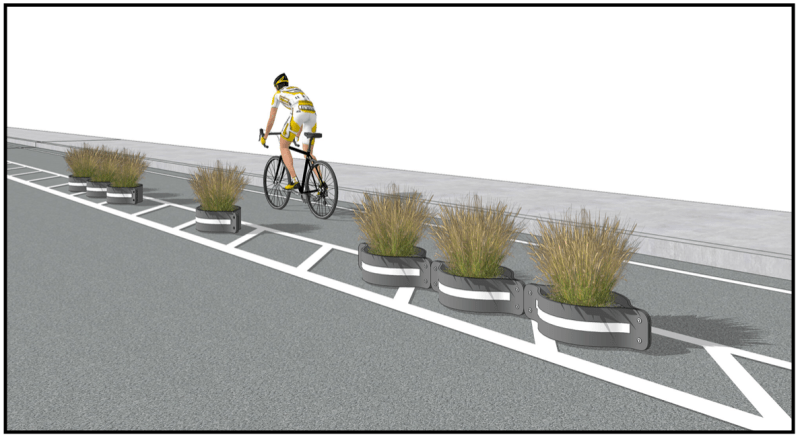Road users who are tired of contending with car traffic on their ride could soon get some relief — thanks to an ultra-affordable mobility lane made out of recycled car tires.
The WeClaim lane delineator won first place in the Build a Better Barrier competition, which was hosted by micromobility company Spin in response to the surge in active transportation during the coronavirus pandemic. Milwaukee-based advocate Caressa Givens and designer Arthur Talayko were awarded a $1,000 prize for their submission, and a prototype of their design will be manufactured for a pilot project. Interested cities are encouraged to reach out to Spin if they'd like to see this beaut on their roads:
The design was applauded for providing effective, highly visible protection to vulnerable road users at a low price point — while also repurposing used car tires, which are commonly founded discarded in underserved communities.
"There are car tires everywhere,” said Veronica Davis of Nspiregreen LLC, one of the contest judges. "It’s an opportunity to reuse things that are currently polluting, in particular Black, Hispanic, and also low-income communities. It’s an opportunity to reuse those things and make them beautiful.”
Spin says the WeClaim design will be made available for free to communities, and will need little more than "a simple template, [a few] used tire[s], a few basic hardware store parts, common tools, and a bit of elbow grease" to install and maintain. That's a stark contrast from traditional protected bike delineators, which can range drastically in price based on the cost of heavy construction materials like concrete, not to mention the invisible but hefty price tags on engineering, design, professional construction, and even simple traffic control during lengthy install periods. As a result, a modern, protected bike lanes can costs anywhere from $133,170 to $536,680 per mile, according to the Pedestrian and Bicycle Information Center.
The cost of the WeClaim delineator will vary by community as well, but the team's emphasis on open source design, inexpensive and free materials, a simple installation process, and quick implementation might make it one of the cheapest protected bike lanes available. And it could be more important than ever during the age of a pandemic, when many communities are clamoring for fast answers to the problem of crowded or non-existent bike lanes as erstwhile transit riders continue to shift to sustainable solo modes.
“The COVID-19 pandemic has changed city landscapes overnight, forcing citizens to completely reimagine their commuting habits," said Carlos Cruz-Casas, assistant director of strategic planning for Miami-Dade County’s Department of Transportation and Public Works and another judge of the contest. "Reduced capacity on public transportation and the need to achieve physical distancing has helped all of us rediscover the benefits of active mobility solutions such as bikes and scooters."
If the WeClaim lane doesn't suit a particular community, Spin also emphasized that the runner up designs are also available for potential pilots. Here are just a few.





